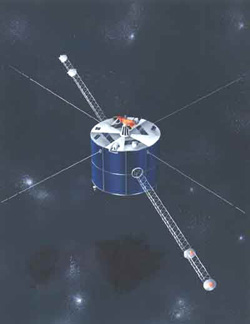The GEOTAIL mission is a collaborative project undertaken by the Japanese Institute of Space and Astronautical Science (ISAS) and the National Aeronautics and Space Administration (NASA). Its primary objective is to study the dynamics of the Earth’s magnetotail over a wide range of distances extending from the near-Earth region (8 Earth radii (Re) from the Earth) to the distant tail (about 200 Re). The GEOTAIL spacecraft was designed and built by ISAS and was launched on July 24, 1992.
The Geotail mission measures global energy flow and transformation in the magnetotail to increase understanding of fundamental magnetospheric processes. This includes the physics of the magnetopause, the plasma sheet, and reconnection and neutral line formation (i.e., the mechanisms of input, transport, storage, release and conversion of energy in the magnetotail). Geotail, together with the Wind, Polar, SOHO, and Cluster missions, constitute a cooperative scientific satellite project designated the International Solar-Terrestrial Physics (ISTP) program which aims at gaining improved understanding of the physics of solar terrestrial relations.
Geotail is a spin-stabilized spacecraft utilizing mechanically despun antennas with a design lifetime of about four years. The nominal spin rate of the spacecraft is about 20 rpm around a spin axis maintained between 85 and 89 deg to the ecliptic plane. Geotail is cylindrical, approximately 2.2 m in diameter and 1.6 m high with body-mounted solar cells. Geotail also has a two-hour back-up battery subsystem which operates when the spacecraft is in the Earth’s shadow.
Real-time telemetry data transmitted in the X-band are received at the Usuda Deep Space Center (UDSC) in Japan. There are two tape recorders on board, each with a capacity of 450 Mbit which allow daily 24-hour data coverage. The data are collected in playback mode by the NASA Deep Space Network (DSN).
The Geotail mission is divided into two phases. During the initial two-year phase, the orbit apogee was kept on the night side of the Earth by using the Moon’s gravity in a series of double-lunar-swing-by maneuvers that resulted in the spacecraft spending most of its time in the distant magnetotail (maximum apogee about 200 Re) with a period varying from one to four months. In February 1995, phase two was commenced as the apogee was reduced to 30 Re to study the near-Earth magneto-tail processes. [Source: NASA]
University of Minnesota Geotail Publications
- Sigsbee, K., et al., FAST – Geotail correlative studies of magnetosphere – ionosphere coupling in the nightside magnetosphere, Geophys. Res. Lett., 25, 1998.
Data
GEOTAIL data hosted at University of Minnesota
Links
Another GEOTAIL NASA site

